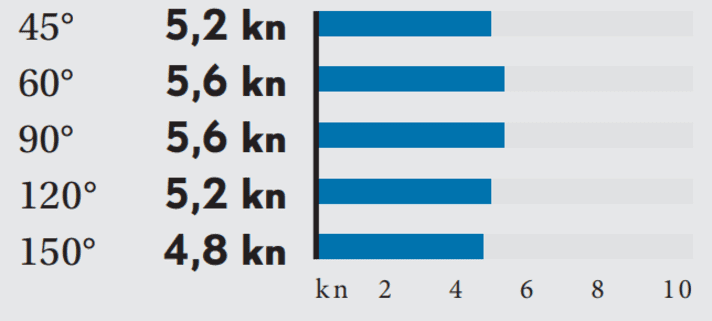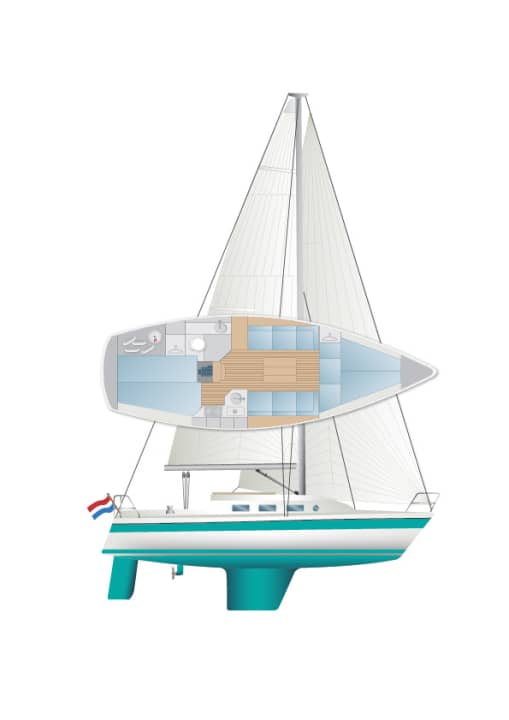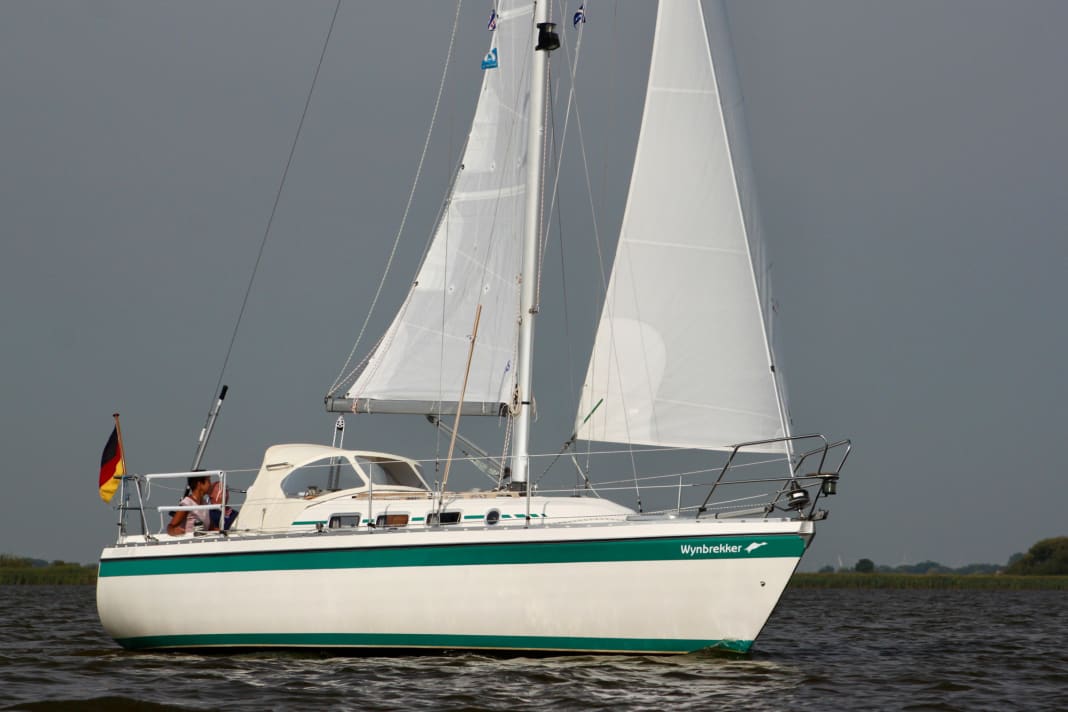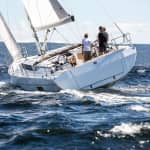In this article:
The shipyard and ship have an eventful history. The former had six different locations and at least as many owners and bankruptcies. The Friendship 28 itself was available in various lengths, different draughts, interior layouts and superstructure layouts. Ships were even delivered for self-construction. What they all have in common, however - almost surprisingly given the history of the manufacturer and model - is that the manufacturing quality is consistently considered solid. Robustly built, with proper fittings, a good sailor and even with some space inside. In short: a well-rounded package.
This was well received. Between 1974 and 1984, 400 were built, almost one per week. However, production continued in the 1990s - at various successor shipyards, with more or less adjustments to the concept and design. Unfortunately, the exact number of units built can no longer be traced. It could well be just under 700 in the various versions.
The biggest improvements have been made to the windows and rear
The test boat has the number 641, and it is from the last series. The biggest changes in the course of its history are certainly the switch from the original, notoriously leaky large windows with aluminium profiles as frames to the panes supplied ready-made by the manufacturer, which are also installed in the test boat. This solved the problem with the lack of tightness. The second major change was the length. The boat has grown by 20 centimetres over time. This was achieved by gluing an extension to the stern, a so-called scoop. This did nothing for the interior, only the sailing performance benefited.
And it is actually good. A high ballast ratio of up to 47 per cent ensures rigidity. The same applies to the solid laminated hull. Designer Dick Koopmans is also known for his very seaworthy boats. According to various owners, this also applies to the Friendship 28. During the test on the Slotermeer in Friesland, the ship was unable to prove how it behaves when the going gets a little rougher due to the lack of swell.
Good sailing characteristics, fine control
What the Friendship was able to demonstrate almost impressively, however, were its good sailing characteristics. It blows at a constant twelve knots. The test boat has a shallow keel of 1.20 metres, or alternatively 1.60 metres, and a fixed pitch propeller. Nevertheless, 5.2 knots are possible high up in the wind. The turning angle is then less than 90 degrees. What is impressive, regardless of the sailing performance, is the ease of operation. The cockpit is large, the traveller runs across the entire width of the bridge deck and the fittings for the mainsheet are ample. This allows the boat to be finely controlled. However, the tiller in the cockpit makes it a little cramped under sail, as the foresheet also needs to be operated.
What's good is that you can sit on the coaming and steer from there using the tiller extension. Here too, both the mainsheet and other trimming devices such as the lines of the adjustable genoa lifting points are easy to reach. Once well trimmed, the boat can be easily steered to the windward edge while maintaining a full overview and keeping an eye on the trim lines. The strong upwind tendency described in some forums did not materialise on the test boat.
Admittedly: With twelve knots of wind, that's no wonder. In addition, the various shipyard owners have made various changes over the years. These included a slightly different skeg and an adapted rudder shape. One thing stood out while sailing: The sum of the high freeboard, cabin superstructure and cockpit coaming, coupled with the high ballast ratio and the resulting great stability, conveys an enormous feeling of safety. This is where you want to be even when the conditions get rougher. The rig also makes a very solid impression. The baby stay certainly contributes to this, although it does get in the way when tacking. This becomes even more serious when the optional 150 per cent genoa is used, because then the crew has to wind a lot of cloth around the steel wire on the foredeck. That takes time.
The engine is the sore point
We return to the harbour under engine power. The MD 2020 from Volvo Penta has a saildrive. Older models have engines from Bukh or Yanmar and are driven by a shaft. The sound insulation is good, as is the accessibility. On older boats, the engine is certainly a sore point. Single-circuit cooled drives with several decades under their belt are nearing the end of their life. This should be taken into account when choosing a Friendship 28. Ideally, the engine has already been replaced. Otherwise the tip is: buy cheaper with an old engine and budget for the replacement.
Everything is there below deck: two cabins, a saloon, a decent galley and a separate wet room. That almost says it all. But only almost. Because the assumption that everything can be just as big on a 28-foot boat as on, say, a 34-footer is of course an illusion. Standing height is an important issue. The maximum in the saloon is 1.84 metres. In the wet room it is 1.74 metres. It is also quite cramped.
Cabins, wet room, galley, storage space - everything a family needs on a yacht for touring sailing
Yes, everything is there, except a lot of space. However, the size of the berths is perfectly acceptable. In the foredeck they are 1.98 by 1.47 metres, and the height is okay. It's a different story aft. At first glance, the berth is large at 2.13 by 1.50 metres. Inside, however, the length is only 1.76 metres because the engine also takes up space. Under the cockpit, the bunk is only 44 centimetres high. However, it is open to the interior so that there is no feeling of oppression.
You feel at home in the saloon. The upholstery is comfortable, the dimensions and ergonomics of the benches are perfectly acceptable, as is the table surface. What is striking is that the Friendship is not as gloomy below deck as one would expect from Koopmans' Breehorn or Victoire designs. The various windows, especially those on both sides of the companionway, bring light into the interior. As many of them can be opened, the issue of ventilation below deck has also been resolved. Cooking is also possible on the Friendship. The test boat has a two-burner gas cooker and a cupboard underneath; there are also models with a cooker and oven - there is enough space under the cooker - but then without a cupboard. There are plenty of these on the Friendship. All of them are easy to use. The wet room next to the companionway only appeared in later model versions. In older ships, it is located in the foredeck between the saloon and the berth. Then the galley is where the toilet was later located.
The robust ship justifies major repairs
The construction method is quite complex: Hand lay-up and solid laminate in the hull. The Friendship is not light: 3.5 tonnes for 28 feet is quite a statement. However, it is her robustness that also justifies major repairs, such as osmosis restoration. The ship's substance is up to the task. However, it is important that the deck is not soft. Unfortunately, this often happens with older balsa sandwich constructions due to water ingress. The result: the deck bounces and becomes soft. This can be repaired, but is very time-consuming. For this reason, special attention should be paid to the deck during an inspection.
The 28 is a bit like a VW Golf. It does very little wrong. Enough space, but not very much. Brisk, but not really fast, solid, but not immortal. A very good compromise of many things. In this respect, the Friendship 28 is a no-nonsense boat for young families looking for safety, but also sailing fun and space below deck. Alternatives to the Friendship 28 are the Victoire 933, the Contest 28 or 29, possibly the Dehler 28, at least the newer models, or the Etap 28i. In any case, the Friendship has very few weaknesses.
Technical data Friendship 28
- Design engineer:Dick Koopmans
- CE design category: B
- Hull length: 8.70/8.90 m
- Waterline length: 7.00/7.10 m
- Width: 2.85 m
- Draught/alternative: 1.60/1.20 m
- Theoretical hull speed: 6.0 knots
- Weight: 3.5 tonnes
- Ballast/proportion: 1.5 t/43 %
- Mainsail: 14.5 m²
- Genoa I: 27.5 m²
- Genoa II: 19.3 m²
- Spinnaker: 59.0 m²
- Mast height above waterline: 11.60 m
- Machine (e.g. Volvo): 13 hp
- Fuel tank: 55 litres
- Fresh water tank: 100 litres
Sailing performance (without drift/current)

Wind speed: 12 to 14 kn (4 Bft), wave height: none
Potential STZ = 4.3/3.8

The sail carrying capacity varies depending on the foresail size. Both values clearly identify the boat as a cruising yacht
Model history
Built since 1974, it was initially 8.70 metres long and was offered with gangways of 1.20 or 1.60 metres. The windows were integrated into the superstructure in aluminium frames, which frequently leaked. The shipyard replaced the windows with standard parts. These are leak-proof. Later, the ship was extended by 20 centimetres with an extension. In more recent models, isophthalic acid resin was used in the outer layers to improve osmosis resistance. The boat was finally rebuilt by the de Slinke shipyard, which moved the keel aft to reduce windward yaw.

The Friendship 28 as a used boat
Market situation
Most of the ships can be found in the Netherlands, as the Friendships were built there. Pay close attention to the engine: Has the expensive component already been replaced or is it at least dual-circuit cooled?
Pay attention to this
In addition to the windows, be sure to check the balsa core in the deck. It should not yet be soft, especially in the area of the fittings. Osmosis can occur. The finishing quality of self-builds is quite heterogeneous, that of shipyard builds is high.
Prices
- Market launch price29.722€
- Price used10,000 to 30,000€
YACHT review Friendship 28
The Friendship 28 is robust, reliable and sails well. The room layout and space conditions are good considering the size. All in all, a real used boat tip
Design and concept
- + Solid construction
- + Timeless lines
- + Various draughts
- - Rig requires baby stay
- - Low interior heights
Sailing performance and trim
- + Good sea behaviour
- + Decent performance
- - Height with shallow keel
Living and finishing quality
- + High quality for shipyard buildings
- - Heterogeneous for self-builds
- - Often leaky windows
- + - Open aft chamber
Equipment and technology
- + Good fittings
- + perforated strip
- + Successful cockpit layout







